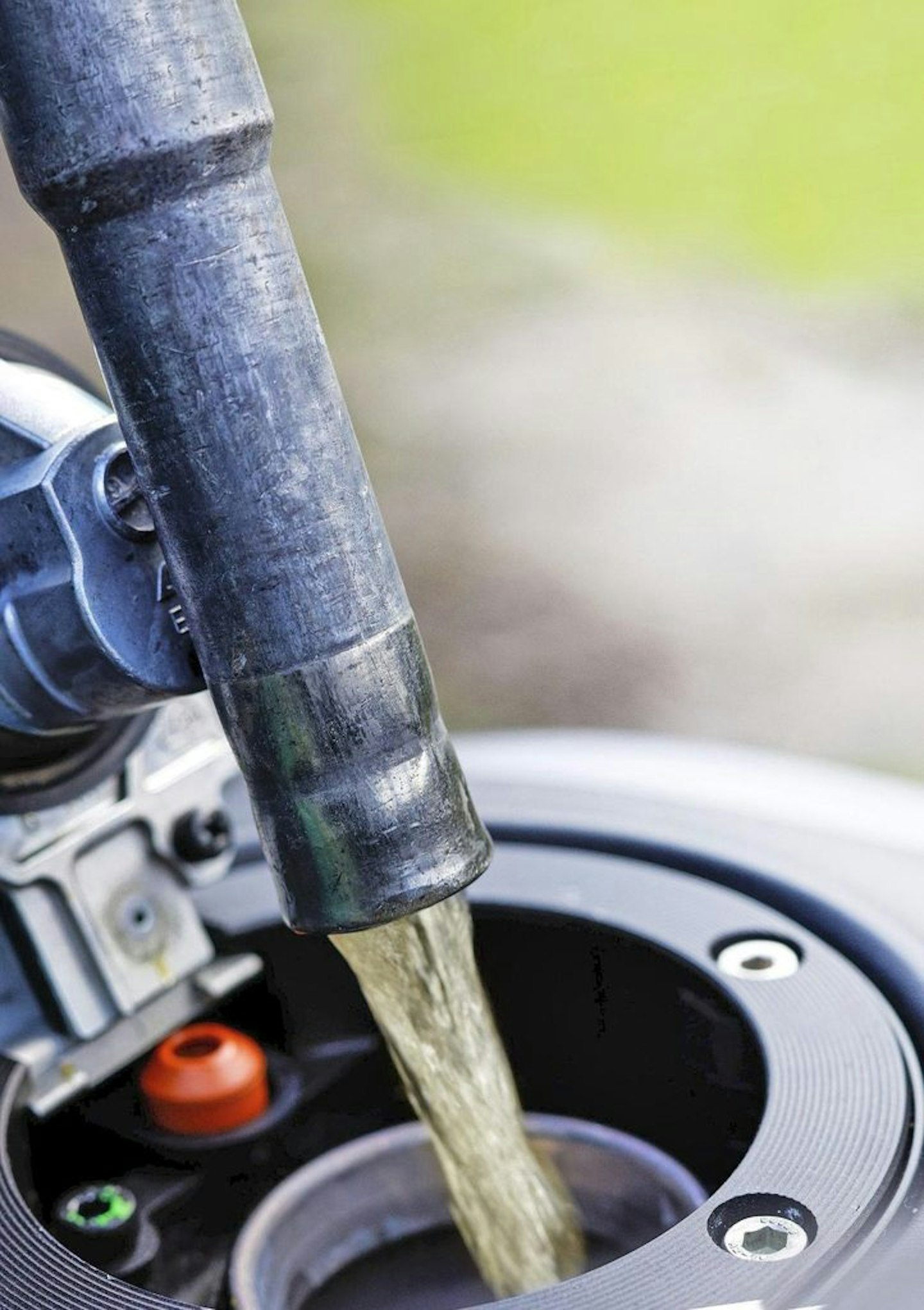KNOWLEDGE
Modern fuel is a giddy mix of petrol, ethanol and additives. But how does it all affect your classic bike?
Photography JASON CRITCHELL

Alan Seeley

'I run my classics on super unleaded and have never bothered with additives. They seem to run fine.’
What’s in modern pump fuel?
Under the terms of the UK Renewable Transport Fuel Obligation, 10% of all road vehicle fuel now has to be from ‘sustainable renewable sources’.
Of course, ‘sustainable renewable sources’ means ethanol. This is made by fermenting grain or sugar cane. Ethanol is claimed to be partially carbon-neutral, because the plants absorb more CO2 as they grow than is released in the production or burning of ethanol.
Any fuel company that retails more than 450,000 litres of fuel a year, defined as ‘major suppliers of fossil fuels’, is obliged to add ethanol to their fuel.
In the UK, standard unleaded fuel is E10. This indicates that it consists of not less than 90% regular unleaded and up to 10% ethanol. Its Research Octane Number (RON) is 95.
Super unleaded is E5, denoting 5% ethanol, 95% unleaded. Its RON rating is typically 97/98, although Shell’s V-Power unleaded is 99 RON.
The E10 and E5 tags do not necessarily indicate the exact proportion of ethanol, merely the maximum, as fuel manufacturers are able to meet their obligations across all road vehicle fuels, including diesel.
All UK fuel comes from the same refineries, so all brands and retailers have the same base fuels. They differ through the addition of so-called ‘additive packs’. These are added at the terminal, then the delivery tankers are filled with fuel.
Additive packs contain friction modifiers for better fuel economy, detergents to keep engines cleaner, and corrosion inhibitors. They may also contain octane boosters, although the octane is usually set by the formulation of the fuel itself. Up to 0.1% of fuel might be made up of additives.
As these are primarily designed to work with modern engine management systems, there’s a question about whether the engine of your classic can make use of them.
Supermarket petrol is often viewed as inferior to the big-brand fuel, but the difference is the additive pack. Cheaper fuels may have less sophisticated additives.
Does this matter for classics?
The octane rating of ethanol is actually higher than petrol; it also lowers combustion temperatures and offers a more controlled burn. It is slightly less energy-dense than petrol and, depending on how much is in the fuel, your bike might run slightly leaner. Modern closedloop injection systems compensate for this, but older FI systems and carbs might
require a little tweaking for peak performance from regular unleaded. There may also be a very small increase in fuel consumption – less than 1%.
Of greater concern is the damage ethanol can do to older bikes. Ethanol is hygroscopic – it absorbs water. Once it reaches the point of saturation, the ethanol and water separate out of the fuel in a process called phase separation. The higher the temperature, the more water there is. An E10 fuel might contain 0.5% water at 15°C. To delay the process, fuel companies add ethanol at the last possible moment, typically at the time when the additive packages are introduced.
Water sinks to the bottom of a bike’s fuel tank during phase separation and if it forms sufficient volume and is left for long enough, it can corrode the fuel system. Water also alters the pH of the fuel, and it becomes more acidic. If all that weren’t bad enough, ethanol is also a solvent and forms gummy substances that can attack the plastics, rubber and metal found in a fuel system. Glassfibre and some plastic fuel tanks really don’t like ethanol fuels.
The panic when lead was removed from forecourt fuel in the 1990s was mostly about valve recession caused by the loss of the lubricating lead and additional heat. The issue was not as extensive as feared, although some owners opted for hardened valve seats or used lead replacement additives. Loss of tappet clearance suggests that you may have an issue.
What can we do about it?
There is plenty of information available regarding ethanol and more recent machines. You can check on E10 compatibility of mostly newer machines at gov.uk/check-vehicle-e10-fuel.
Yamaha say that bikes from model year 1990 are compatible with E10. Older models should use E5. Honda’s position is that motorcycles and mopeds produced for the EU market since 1993 “can use ethanol-blended gasoline up to 10% although carburettor-equipped models could experience poor driveability in cold weather conditions”.
A long list of noughties-onwards Ducatis are said to be OK with E10; anything not listed should use E5. Kawasaki have also listed E10-compatible models, with the recommendation to use E5 if not specified.
Suzukis made after 2002 can use E10, as can some built from 1992 to 2001, and the UK importers can clarify which. Pre-1991 Suzukis are apparently not E10 safe and RON 98 fuel with no bio-fuel content is recommended. Tricky, because while super unleaded sold by some brands in certain parts of the country might have no ethanol, you can’t rely on that.
Safest to assume that any bike built before 1990 is likely to have issues with ethanol.
So what to do? You could simply run with the lowest ethanol content pump fuel available and keep your mileage up so that the fuel is used before phase separation and hence water absorption take effect. If your bike will be standing for a time, either brim the tank or drain the system dry. There are also fuel stabilisers available that claim to slow or stop phase separation.
Some classic owners use products like Tetraboost, an additive which is said to give the characteristics of the old four and five star fuel, boosting octane while protecting from the effects of ethanol. It costs just under 50p to treat a litre of fuel and can’t be used with catalytic converters.
Are there alternatives?
The 450,000-litre rule that the big fuel companies have to adhere to for ethanol addition means there is an exemption for small manufacturers to sell ethanol-free fuel, which can be bought by the drum. One such is Aspen, however you’re looking at around £4 per litre plus costly shipping, and not all companies will ship so you’ll have to collect. Fuel stored at home has to be in a proper container and you shouldn’t have more than 20 litres.
Last year Coryton launched the UK’s first plant-based fuel for classics, Sustain. It’s a 98 RON+ fuel with less than 1% bioethanol and requires no tweaking of the fuel system. This is distinguished from bio-fuel added to fossil fuel by being wholly plantbased. Green though it is, it’s an expensive alternative for the moment, at around £4 per litre. Last year the Goodwood Revival Meeting mandated that cars and bikes raced at the event must run on fuels with at least 70% sustainable components. It’s a positive signal that classics have a working future, even if the ethanol content of forecourt fuel increases.
Get out and ride
For now, you’d best fuel-proof your bike, replacing seals, fuel lines and carb components with ethanol-safe items. Vulnerable tanks should be lined with appropriate sealants. If you’re worried about the lack of lead in modern fuels, use an additive or wait for valve recession to occur, then fit hardened valve seats.
Most of all, just get out there and ride. Fresh fuel causes least problems.
